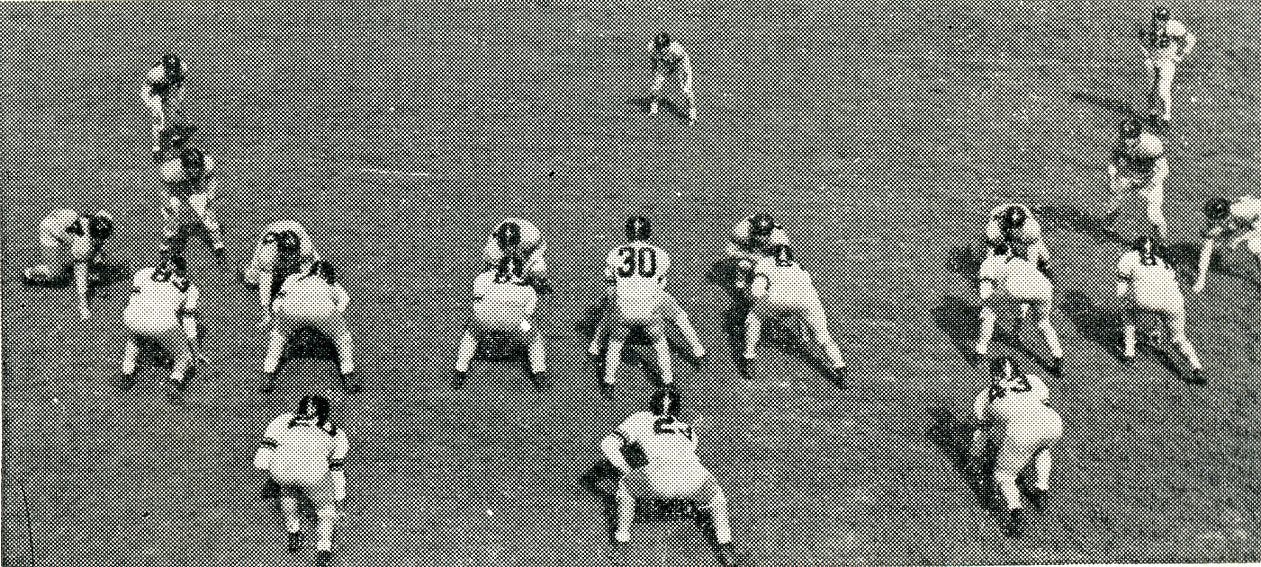Today's Tidbit... The RPO of 1947
My recent book, Hut! Hut! Hike!, looks at when various elements of football's vocabulary entered the game and what was happening in football that caused them to coin a new term. For example, the run-pass option emerged after WWII, and the term has been used since then. However, the abbreviation, RPO, is more recent, first appearing in a newspaper in 2015.
Option football arrived with Don Faurot's Split-T Offense in 1941. Faurot put horizontal pressure on defenses by using even wider splits in the line than those used with the Modern T. In addition, the splits among the backs also widened.
More critically, the Split T introduced the option running attack to football. As in the Modern T, the quarterback aligned under center, and his first movement post-snap was to give or fake a quick-hitting halfback dive.
The Split T's dive play was predetermined, meaning the quarterback called the give or fake in the huddle; it was not an option read. After faking the dive, the quarterback continued moving to the outside and parallel to the line of scrimmage, reading the defensive end, who was left unblocked by the offensive line. If the defensive end penetrated the backfield or moved to the outside, the quarterback kept the ball and turned upfield.
On the other hand, if the defensive end attacked the quarterback, the quarterback pitched to the sweeping halfback. (Unlike the one-handed, thumb-under pitch used in later forms of the option, the Split T quarterback tossed the ball underhand using both hands.) Since the quarterback ran directly behind the line of scrimmage on the base series, he was within five yards of the line and could not legally pass the ball until the college rules changed in 1945. Even after the rule change, Split T quarterbacks remained too close to the line to pass effectively, so the halfbacks handled the passing, as they did in the Single Wing. The halfback often had the choice to run with the ball or pass to an open receiver, which was the basis of the run-pass option.
Of course, teams had been sending halfbacks wide for some time with the option to run or pass, but they did not refer to it as an option until Faurot's run option came along. Another coach who used the run-pass option was Lou Little at Columbia, who did so out of a Broken T, as seen in his "Optional End Run Forward Pass" that appeared in an Atlas Tire giveaway from 1947. (Note the left halfback is player #4, though someone scribbled over the #4 sometime in the past.)
I won't repeat Little's explanation of the play and the backs' responsibilities but will point to the coaching point about the left halfback reading the defensive halfback to determine whether to run or pass. If the defensive halfback drops back with the end, the left halfback should likely run. If the halfback provides run support, the end should be open for the pass.
That is the core idea behind today's RPOs. Of course, offenses and defenses are far more complex nowadays, but in many cases, RPOs take us back to simpler passing decisions such as those Lou Little espoused.
A final note about Lou Little's play diagram is it appeared in a booklet published before the 1947 season. Columbia apparently used the play effectively because the Lions beat Army midway through the season to end the three-time national champion Cadets' 32-game unbeaten streak.
Football Archaeology is reader-supported. Click here to buy one of my books or otherwise support the site.




